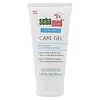What's inside
What's inside
 Key Ingredients
Key Ingredients

 Benefits
Benefits

 Concerns
Concerns

 Ingredients Side-by-side
Ingredients Side-by-side

Water
Skin ConditioningCocamidopropyl Betaine
CleansingGlycerin
HumectantSodium Methyl 2-Sulfolaurate
CleansingDisodium 2-Sulfolaurate
CleansingHydrolyzed Wheat Protein
Skin ConditioningTrehalose
HumectantAllantoin
Skin ConditioningSantalum Acuminatum Fruit Extract
AntioxidantCitrus Glauca Fruit Extract
HumectantAcacia Victoriae Fruit Extract
AntioxidantTasmannia Lanceolata Fruit Extract
Skin ConditioningHordeum Vulgare Powder
AbrasivePhenoxyethanol
PreservativeBenzoic Acid
MaskingDehydroacetic Acid
PreservativeCitrus Reticulata Peel Oil
MaskingCitrus Paradisi Peel Oil
MaskingParfum
MaskingCitrus Junos Extract
AntioxidantAbies Sibirica Oil
MaskingLimonene
PerfumingWater, Cocamidopropyl Betaine, Glycerin, Sodium Methyl 2-Sulfolaurate, Disodium 2-Sulfolaurate, Hydrolyzed Wheat Protein, Trehalose, Allantoin, Santalum Acuminatum Fruit Extract, Citrus Glauca Fruit Extract, Acacia Victoriae Fruit Extract, Tasmannia Lanceolata Fruit Extract, Hordeum Vulgare Powder, Phenoxyethanol, Benzoic Acid, Dehydroacetic Acid, Citrus Reticulata Peel Oil, Citrus Paradisi Peel Oil, Parfum, Citrus Junos Extract, Abies Sibirica Oil, Limonene
 Reviews
Reviews

Ingredients Explained
These ingredients are found in both products.
Ingredients higher up in an ingredient list are typically present in a larger amount.
Allantoin is a soothing ingredient known for its protective and moisturizingg properties. Because of this, it is often added to products with strong active ingredients.
Studies show higher concentrations of this ingredient can promote wound healing.
Though it can be derived from the comfrey plant, allantoin is produced synthetically for cosmetic products to ensure purity.
Learn more about AllantoinGlycerin is already naturally found in your skin. It helps moisturize and protect your skin.
A study from 2016 found glycerin to be more effective as a humectant than AHAs and hyaluronic acid.
As a humectant, it helps the skin stay hydrated by pulling moisture to your skin. The low molecular weight of glycerin allows it to pull moisture into the deeper layers of your skin.
Hydrated skin improves your skin barrier; Your skin barrier helps protect against irritants and bacteria.
Glycerin has also been found to have antimicrobial and antiviral properties. Due to these properties, glycerin is often used in wound and burn treatments.
In cosmetics, glycerin is usually derived from plants such as soybean or palm. However, it can also be sourced from animals, such as tallow or animal fat.
This ingredient is organic, colorless, odorless, and non-toxic.
Glycerin is the name for this ingredient in American English. British English uses Glycerol/Glycerine.
Learn more about GlycerinPhenoxyethanol is a preservative that has germicide, antimicrobial, and aromatic properties. Studies show that phenoxyethanol can prevent microbial growth. By itself, it has a scent that is similar to that of a rose.
It's often used in formulations along with Caprylyl Glycol to preserve the shelf life of products.
Water. It's the most common cosmetic ingredient of all. You'll usually see it at the top of ingredient lists, meaning that it makes up the largest part of the product.
So why is it so popular? Water most often acts as a solvent - this means that it helps dissolve other ingredients into the formulation.
You'll also recognize water as that liquid we all need to stay alive. If you see this, drink a glass of water. Stay hydrated!
Learn more about Water